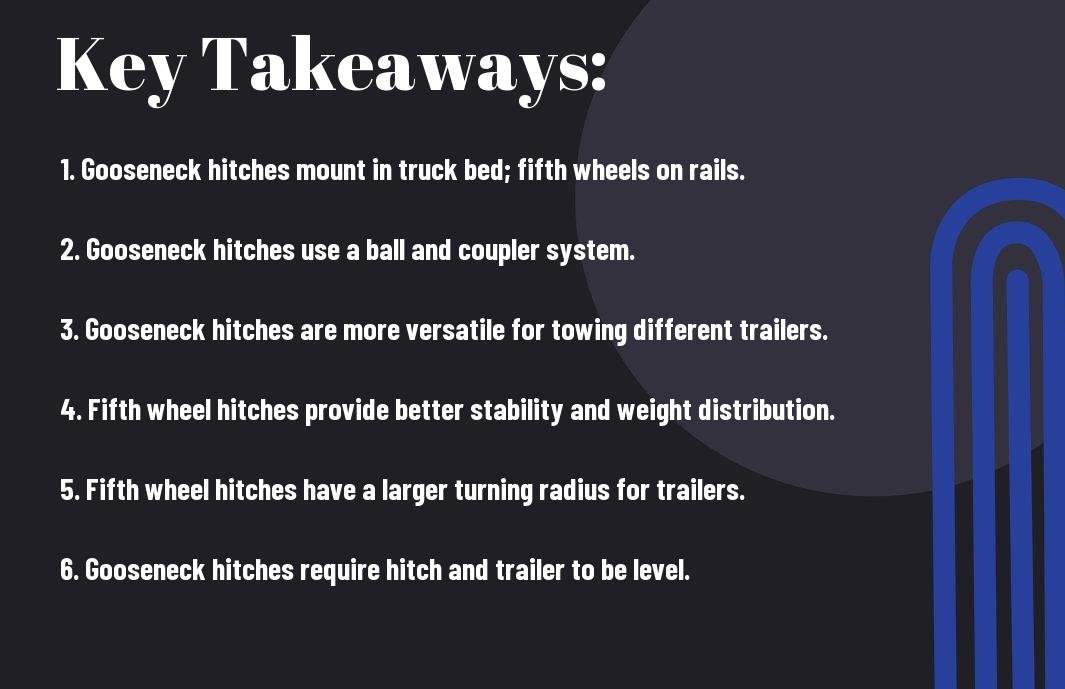When it comes to towing heavy trailers, it’s crucial to understand the nuances between a gooseneck and a fifth wheel hitch. Making the wrong choice could result in dangerous consequences for you and your vehicle. The key differences between these two hitch types lie in their design and functionality. Understanding these differences will help you make an informed decision and ensure a safe towing experience. In this blog post, we will delve into the important distinctions, benefits, and potential risks associated with both gooseneck and fifth wheel hitches, empowering you to choose the right hitch for your needs.
Key Takeaways:
- Connection Point: A gooseneck hitch connects to the bed of a truck via a ball mounted in the center, while a fifth wheel hitch connects via a hitch located in the center of the truck bed.
- Weight Capacity: Fifth wheel hitches typically have a higher weight capacity than gooseneck hitches, making them suitable for heavier loads.
- Maneuverability: Gooseneck hitches offer better maneuverability because the hitch is mounted closer to the rear axle, while fifth wheel hitches provide improved stability.
- Installation: Installing a gooseneck hitch requires drilling a hole in the truck bed, while a fifth wheel hitch usually requires a professional installation due to its complex design.
- Trailer Types: Gooseneck hitches are commonly used for horse trailers and flatbeds, while fifth wheel hitches are preferred for RVs and heavy trailers.
- Cost: Generally, gooseneck hitches are more affordable than fifth wheel hitches, making them a popular choice for towing smaller loads.
- Compatibility: When choosing between a gooseneck and a fifth wheel hitch, it’s essential to consider the compatibility with your specific truck and trailer setup to ensure a secure and efficient towing experience.

The Gooseneck Hitch
Even if you’re new to towing, you’ve probably heard about gooseneck hitches. They’re popular among those who need to tow heavy loads, but what exactly makes them different from other hitch types? Let’s dive in and take a closer look at the gooseneck hitch.
Definition and Design Features
A gooseneck hitch is designed to attach to the bed of a pickup truck, just above the rear axle. It consists of a ball that protrudes from the bed and connects to a coupler on the trailer. One of the key design features of a gooseneck hitch is its use of a ball and coupler, which allows for a secure and stable connection between the truck and the trailer. This design also allows for a greater range of motion, making it easier to navigate tight turns and maneuver the trailer.
Benefits of Using a Gooseneck Hitch
One of the biggest benefits of using a gooseneck hitch is its enhanced stability and weight-carrying capacity. The design of the hitch allows for the weight of the trailer to be distributed more evenly between the front and rear axles of the towing vehicle, resulting in improved handling and control. Additionally, the gooseneck hitch is often favored for its ability to tow larger and heavier trailers compared to other types of hitches.
Common Applications and Vehicles
Gooseneck hitches are commonly used for towing larger trailers, such as horse trailers, RVs, and flatbeds. They are also popular among farmers and those in the construction industry for hauling heavy equipment and materials. If you have a pickup truck and need to tow heavy loads, a gooseneck hitch may be the right choice for you.
The Fifth Wheel Hitch
For towing heavier loads, a fifth wheel hitch is a popular choice for many drivers. This type of hitch is designed to provide a secure connection between your vehicle and the trailer, allowing for a smooth and safe towing experience. In this section, we’ll take a closer look at the definition, characteristics, advantages, and typical uses of a fifth wheel hitch.
Definition and Design Characteristics
A fifth wheel hitch is named after the coupling arm that resembles a wheel. It is installed in the bed of a pickup truck and uses a jaw mechanism to lock the kingpin of the trailer in place. This design provides a secure and stable connection, allowing for better weight distribution and maneuverability while towing. The hitch is typically mounted on a set of rails that are bolted to the truck bed, providing a solid foundation for towing heavy loads.
Advantages of a Fifth Wheel Hitch
One of the primary advantages of a fifth wheel hitch is its stability and weight-bearing capacity. The design of the hitch allows for the weight of the trailer to be centered over the rear axle of the towing vehicle, which can improve handling and control while on the road. Additionally, the design of the hitch allows for a tighter turning radius, making it easier to maneuver in tight spaces such as campgrounds or parking lots.
Typical Uses and Compatible Vehicles
Fifth wheel hitches are commonly used for towing large trailers such as RVs, horse trailers, and heavy equipment. They are a popular choice for long-haul truckers and recreational vehicle enthusiasts due to their stability and towing capacity. Compatible vehicles for fifth wheel hitches typically include pickup trucks with an appropriate towing capacity, as well as the necessary installation of a hitch mounting system in the truck bed.
By choosing a fifth wheel hitch, you can enjoy the stability, payload capacity, and maneuverability needed for safely towing heavy loads.
Comparing Gooseneck and Fifth Wheel Hitches
Now let’s take a closer look at the differences between gooseneck and fifth wheel hitches. Each type of hitch has its own set of advantages and considerations when it comes to towing, stability, and compatibility with your towing vehicle. Below is a breakdown of the key differences between these two popular hitch options:
| Aspect | Gooseneck Hitch |
| Towing Capacity and Stability | Fifth Wheel Hitch |
| Hitching and Unhitching Processes | Gooseneck Hitch |
| Compatibility and Installation Requirements | Fifth Wheel Hitch |
| Maneuverability and Use Cases | Varies – Depending on your specific towing needs |
Towing Capacity and Stability
When it comes to towing capacity and stability, fifth wheel hitches are known for their superior performance. They are designed to distribute the weight of the trailer more evenly between the front and rear axles of the towing vehicle, providing greater stability and control, especially when towing heavy loads. The unique design of the fifth wheel hitch also results in reduced swaying and improved maneuverability on the road, giving you a safer and more controlled towing experience.
Hitching and Unhitching Processes
One of the main advantages of a gooseneck hitch is the ease of hitching and unhitching the trailer. The design of the gooseneck hitch allows for quick and hassle-free attachment and detachment of the trailer, making it a convenient option for frequent towing needs. The process typically involves a simple drop-and-lock mechanism, saving you time and effort whenever you need to hook up or disconnect your trailer.
Compatibility and Installation Requirements
When it comes to compatibility and installation requirements, fifth wheel hitches are often the preferred choice. They are commonly used on larger RVs and heavy-duty trailers, offering a secure and reliable towing connection. Additionally, the installation of a fifth wheel hitch usually requires minimal modifications to the towing vehicle, making it a practical option for many towing applications.
Maneuverability and Use Cases
When it comes to maneuverability and use cases, the choice between a gooseneck or fifth wheel hitch will ultimately depend on your specific towing needs. While fifth wheel hitches are favored for their superior towing capacity and stability, gooseneck hitches offer added convenience and ease of use for frequent towing tasks. Consider the weight and size of your trailer, as well as your towing vehicle’s capabilities, to determine which type of hitch best suits your needs.
Conclusion: Understanding the Difference
Presently, you should have a clear understanding of the differences between a gooseneck and a fifth wheel hitch. It is important to remember that while both types of hitches serve the same purpose of towing heavy loads, they have distinct differences in their design and function. Gooseneck hitches are known for their maximum stability and weight capacity, making them ideal for large trailers, while fifth wheel hitches provide easier maneuverability and pivot ability, making them well-suited for recreational vehicles and horse trailers. Understanding these differences will help you make the right choice for your towing needs and ensure a safe and effective towing experience.
FAQ
Q: What is the difference between a gooseneck and a fifth wheel hitch?
A: The main difference between a gooseneck and a fifth wheel hitch is the way they connect to a towing vehicle. A gooseneck hitch uses a ball and coupler system, while a fifth wheel hitch uses a two-piece hitching system with a kingpin and a horseshoe-shaped coupler.
Q: Can a gooseneck hitch and a fifth wheel hitch be used interchangeably?
A: No, a gooseneck hitch and a fifth wheel hitch are not interchangeable. Vehicles and trailers are specifically designed for one or the other, and attempting to use them interchangeably can result in unsafe towing conditions.
Q: How do I choose between a gooseneck and a fifth wheel hitch?
A: The choice between a gooseneck and a fifth wheel hitch depends on the size and type of trailer you are towing. Gooseneck hitches are typically used for smaller trailers and offer a tighter turning radius, while fifth wheel hitches are designed for larger trailers and provide a smoother ride.
Q: What are the main considerations for installing a gooseneck or fifth wheel hitch?
A: When considering installation, it’s important to ensure that your towing vehicle is equipped to handle the specific hitch type. This includes checking the towing capacity, bed size, and any necessary modifications to the vehicle for proper installation.
Q: Do gooseneck and fifth wheel hitches require regular maintenance?
A: Yes, both gooseneck and fifth wheel hitches require regular maintenance to ensure safe and effective towing. This includes inspecting and greasing the hitch components, checking for wear and tear, and following manufacturer guidelines for upkeep.
